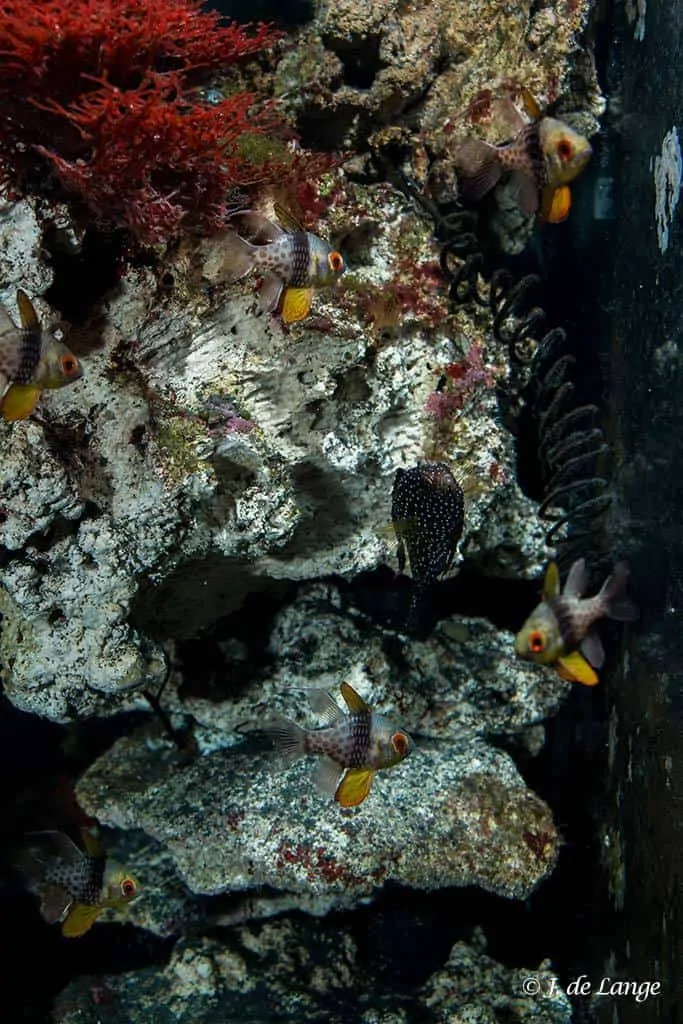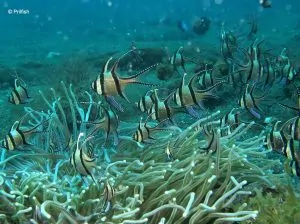Sphaeramia nematoptera – Pajama Cardinalfish
Sphaeramia nematoptera was first described by Bleeker in 1856. Their common name is Pajama Cardinalfish.
The genus name Sphaeramia consists of two ancient Greek words. “Sfaira” means ball, a reference to the round shape of this fish. The second word is “aima”, which means shark, a reference to the high first dorsal fin of this species that looks like a shark fin. The generic name nematoptera is also made up of two ancient Greek words. “Nema” means thread and “pteron” means wing or fin, this is a reference to the second dorsal fin. Adult animals get a long filament at the top of this fin. The genus has only two species: Sphaeramia nematoptera and Sphaeramia orbicularis.
Description
The Pajama cardinalfish is a very striking fish. With high-raised dorsal fins and wide flared belly fins that are colored yellow, they stand quietly in the water. The eye is red in color and strikingly large. Young specimens have a yellow head, which fades as the fish ages. A black vertical line runs from the dorsal fin to just behind the ventral fins. Behind this line, light brown spots can be seen on the otherwise whitish body. The difference between males and females is almost invisible.
A characteristic of Cardinal bass is the dorsal fin which is made up of two parts. With Sphaeramia nematoptera, the front dorsal fin is colored yellow and the second dorsal fin is transparent, just like the pectoral, caudal, and anal fins.
The eyes are so large because it is a nocturnal fish. Only at dusk does Sphaeramia nematoptera come out to look for food. During the day they hide in the dark parts of the coral reefs. You can often find this species in the neighborhood of Diadema setosum or Diadema antillarum. In the event of danger, they seek protection between the long spines of these sea urchins.
Biotope
The Pajama Cardinalfish inhabits the reefs at depths of around 1 to a maximum of around 14 meters. They prefer calm water where the reefs are covered with branched corals such as Acropora species. They preferably use Porites nigrescens and Porites cylindrica. During the day they use the corals to shelter.
They occur on the reefs in the Pacific Ocean and the seas from Japan to the Great Barrier Reef near Australia. Their habitat extends from Java in the west to Fiji in the east.
Diet
In the wild, Sphaeramia nematoptera mainly feeds on animal plankton that floats in the water column. These larvae of fish and young crustaceans. In the aquarium, aquarium-bred specimens are usually not fussy with food. You can then feed them with frozen or live food such as Mysis, Daphnia, Brine Shrimp, finely chopped shrimp, etc. They will probably also know and eat granules.
If you have wild-caught animals, they may not eat dead animal food immediately. You will have to start with live food and gradually adjust it to frozen food.
The Aquarium
This species feels best in a school. When kept alone, they do not feel safe and keep hiding. Eventually they languish. It is better to keep them in a school of at least five but preferably even more. An aquarium from 250 liters for a school of five is sufficient. If the school gets bigger, the aquarium will also have to get a little bigger.
Decorate the aquarium with sufficient hiding places. Pajama cardinalfish are nocturnal fish that hide during the day. If you keep them together with other calm fish, they will eventually come forward during the day. Do not keep them together with busy or too big fish because they will keep hiding. They like a moderate current, with a gentle flow you will often see them standing in the water.
Note that they eat crustaceans, so they will certainly see small shrimps as food. Other reef animals are usually left alone. They are considered as reefsafe.
Because Sphaeramia nematoptera can be bred in captivity fairly easily, aquarium-raised fish can often be found in stores. Aquarium-raised fish have less difficulty adapting to life in an aquarium. This also saves on the stress of catching and shipping. Ask your local fish store for aquarium-raised fish as the chance of successfully keeping them is much bigger.
Reproduction
As said before, they can be bred in captivity. You can also breed them in your own aquarium. You will probably need a separate breeding if you want to raise the fry.
The Pajama Cardinal perch forms a couple before spawning. The eggs are laid on the bottom and fertilized by the male. After fertilizing he takes the eggs in his mouth to hatch them. He incubates the eggs for about 10 days. The young larvae are then released between the spines of their symbiosis sea urchin. The fry are only about 3 millimeters tall.
Video
Author
John de Lange
Copyright images
John de Lange
Resources
Fishbase.org
Monaco Nature Encyclopedia
Aquariumwereld.be
Reefapp.net
Reeflex.net















Reviews
There are no reviews yet.